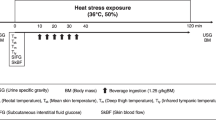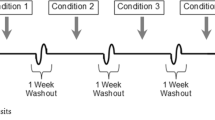Abstract
The increased metabolic heat production in humans exposed to cold stress results from an increased oxidation of both carbohydrate and fat to provide energy to sustain temperature homeostasis. Research suggests that dietary manipulations may enhance metabolic heat production, thereby delaying hypothermia. Therefore, the present investigation examined the thermogenic effect of a sequential timed feeding regime of either a carbohydrate (CHO) or a placebo beverage (PL) before and again midway through 120 min of exposure to 8, 12 and 27° C in well-nourished men. The following were examined: tissue insulation (I), rectal temperature (T re), mean skin temperature\(\bar T_{{\text{sk}}}\), metabolism (M), time-weighted heat production and respiratory exchange ratio (R).T re, ΔT re,\(\bar T_{{\text{sk}}}\) M, ΔM,I and time-weighted heat production revealed no significant differences between treatment (PL vs CHO) at any temperature (8, 12 and 27° C). However,T re decreased (P < 0.05) as time increased at 8, 12 and 27° C while M increased (P < 0.05) andI decreased (P < 0.05) at 8 and 12° C. At 8 and 27° C,R differed (P < 0.05) between the PL and CHO treatments. In addition, at 8 and 12° C,R increased (P < 0.05) across time reflecting the feeding. From these data it appears that while substrate utilization differed between dietary treatment (8 and 27° C) and across time, this feeding regime did not differentially affectT,T re,\(\bar T_{{\text{sk}}}\) andI during 120 min of exposure to 8, 12 and 27° C.
Similar content being viewed by others
References
DuBois D, DuBois EF (1916) Clinical calorimetry. X. A formula to estimate the approximate surface area if height and weight be known. Arch Intern Med 17:863–871
Glickman-Weiss EL, Goss FL, Robertson RJ, Metz KF, Cassinelli DA (1991) Physiologic and thermal responses of males with varying body compositions during immersions in moderately cold water. Aviat Space Environ Med 62:1063–1067
Glickman-Weiss EL, Nelson AG, Hearon CM, Vasanthakumar SR, Stringer B, Shulman SS (1993) Does feeding regime affect physiologic and thermal response to 8, 20 and 27° C? Eur J Appl Physiol 67:30–34
Hagen (1972) Lipid metabolism during cold exposure and cold acclimation. Lipids 7:310–320
Jansson E (1982) On the significance of the respiratory exchange ratio after different diets during exercise in man. Acta Physiol Scand 114:103–110
Keatinge WR (1960) The effects of subcutaneous fat and of previous exposure to cold on the body temperature, peripheral blood flow, and metabolic rate of men in cold water. J Physiol (Lond) 143:166–178
McArdle WD, Magel JR, Gergley TJ, Spina RJ, Toner MM (1984) Thermal adjustment to cold water exposure to resting men and women. J Appl Physiol 56:1565–1571
Nadel ER, Holmes I, Bergh A, Astrand P-O, Stolwijk AJ (1974) Energy exchange of swimming men. J Appl. Physiol 36:465–471
Pendergast DR (1988) The effect of body cooling on oxygen transport during exercise. Med Sci Sports Exerc 20:S171-S176
Rennie DW, Cavino BG, Howell BJ, Hong SH, Kang SH, Hong SK (1962) Physical insulation of Korean diving women. J Appl Physiol 17:961–966
Thompson GE (1977) Physiological effects of cold exposure. In: Robertshaw D (ed) International review of physiology II, vol 1, 15. University Press, Baltimore, pp 29–69
Vallerand AL, Jacobs I (1989) Rates of energy substrate utilization during human cold exposure. Eur J Appl Physiol 58: 873–878
Vallerand AL, Schmegner IF, Jacobs I (1992) Influence of the Cold Buster™ sports bar on heat debt, mobilization and oxidation of energy substrates. Defence and Civil Institute of Environmental Medicine No. 92-60
Vallerand AL, Tikuisis P, Ducharme MB, Jacobs I (1993) Is energy substrate mobilization a limiting factor for cold thermogenesis? Eur J Appl Physiol 67:239–244
Veicsteinas A, Ferretti G, Rennie DW (1982) Superficial shell insulation in resting and exercising men in cold water. J Appl Physiol 52:1557–1564
Wang LCH (1980) Modulation of maximum thermogenesis by feeding in the white rat. J Appl Physiol 49:975–978
Young AJ (1990) Energy substrate utilization during exercise in extreme environments. In: Pandolf KB, Holloszy JO (eds) Exercise and sports science reviews. Williams and Wilkins, Baltimore, pp 65–117
Young AJ, Sawka MN, Neufer PD, Muza SR, Askew EW (1989) Thermoregulation during cold water immersion is unimpaired by low muscle glycogen levels. J Appl Physiol 66:1809–1816
Author information
Authors and Affiliations
Rights and permissions
About this article
Cite this article
Glickman-Weiss, E.L., Nelson, A.G., Hearon, C.M. et al. The thermogenic effect of a carbohydrate feeding during exposure to 8,12 and 27° C. Europ. J. Appl. Physiol. 68, 291–297 (1994). https://doi.org/10.1007/BF00571445
Accepted:
Issue Date:
DOI: https://doi.org/10.1007/BF00571445




